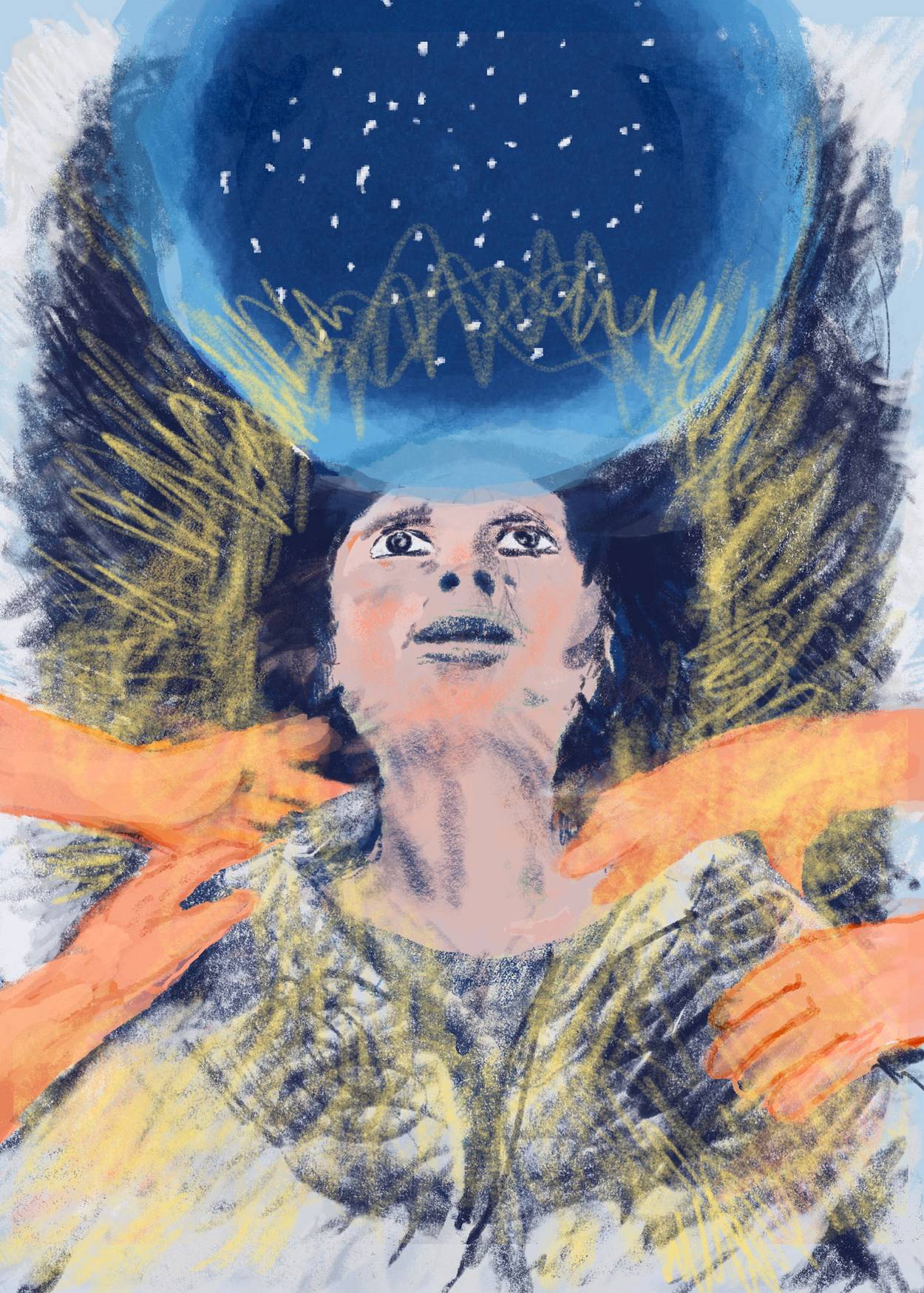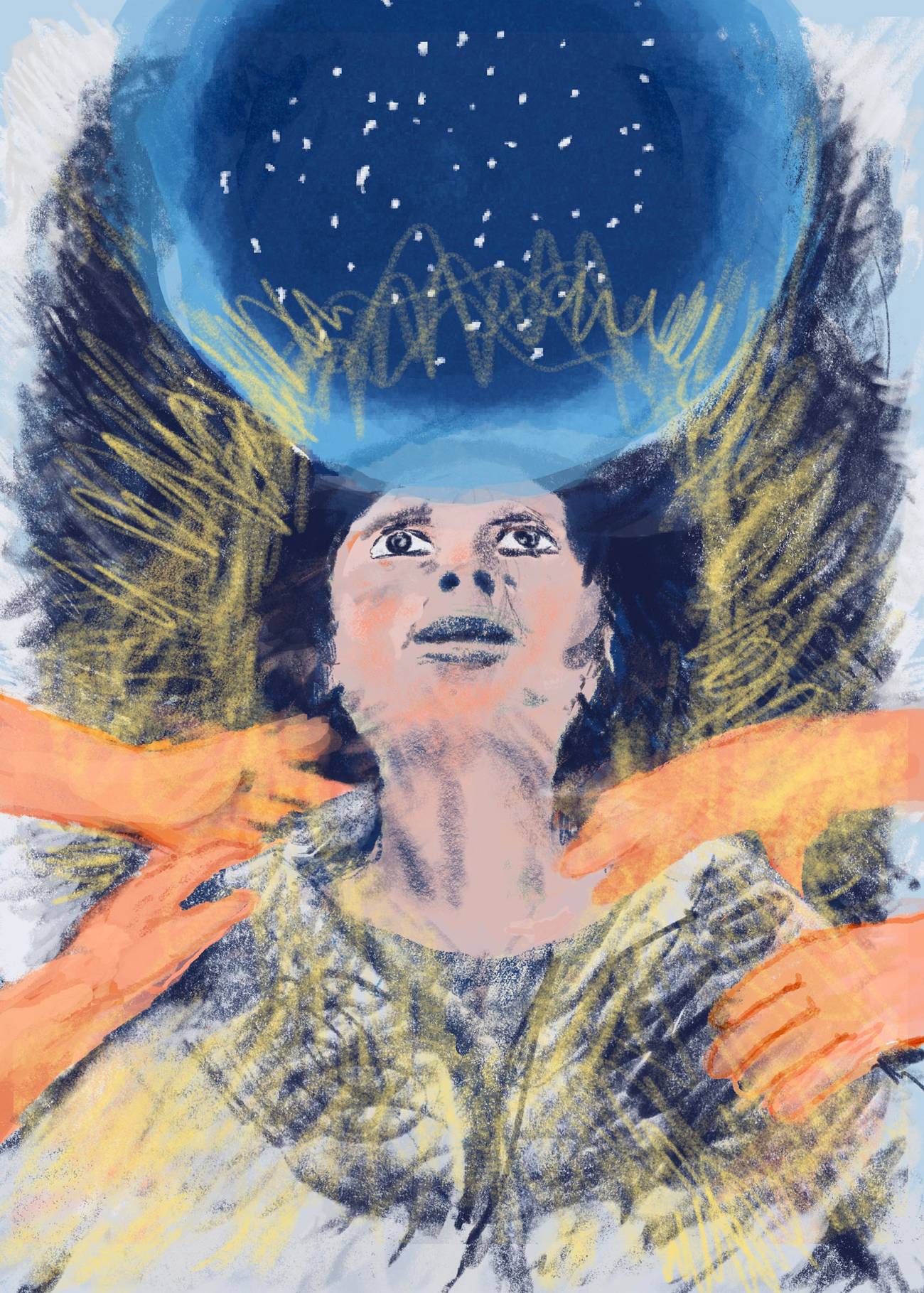Electricity coursed through me during Kol Nidre services last year. The shock caused me to convulse, cry out, and slam my head into the wall behind me. Although I wish I could have avoided the 36 joules that ran through me in an instant, I’ve come to realize there was no better time or place to be pierced out of my complacency.
My defibrillator shocked me just as we finished reciting the Unetaneh Tokef, the liturgical poem (pikkyut) we say four times during High Holidays services.
On Rosh Hashanah it is inscribed,
And on Yom Kippur it is sealed.
How many shall pass away and how many shall be born,
Who shall live and who shall die …
For centuries, Jews on this night have recited the particularities of how we might die in the coming year:
Who shall perish by water and who by fire …
Who by earthquake and who by plague,
Who by strangulation and who by stoning …
I have become something of an expert in living with the possibility of death hanging over me. Not that I anticipate “strangulation or stoning” in the coming months. I have a rare and potentially fatal disease called sarcoidosis. I’ve been sick since I was 33 and my son Andrew was 3 months old.
For the past 19 years, I could write my own verses.
Who by sarcoidosis,
Who by cancers caused by chemotherapies to treat sarcoidosis
My lines certainly don’t soar with the lyricism of the Unetaneh Tokef. But I believed I had reached some level of acceptance of my mortality.
Until last Kol Nidre, I was usually alone or just with my husband when the universe reminded me of my impermanence. The scenes of these memento mori were bland, cramped examination rooms in some hospital or medical office.
Some verdicts were starker than others.
“You could drop dead at any moment,” one doctor told me, keeping his back to my husband, Jay, and me, as he scrolled through MRI images of my heart. Our son was just learning to walk. I felt like the beige hospital walls would close over and suffocate me. I was alone when another doctor told me I wouldn’t live to see my son graduate from high school.
I believed all this practice—with just me and my mortality eyeing each other—made me more accepting of my inevitable death than the average 51-year-old. I also thought my experiences with a never-ending illness caused me to be more empathetic.
But I was not alone during last year’s Kol Nidre services, when my defibrillator shocked me senseless. My small Montana synagogue was full beyond capacity. Even with the chairs crammed together, only a couple of inches between them, we ran out of seats. People were davening in the kitchen behind the sanctuary and squeezed into the hallway next to the bathrooms. I found a seat in the back row, tucked between two women I didn’t know.
My defibrillator gave me no warning before firing. I didn’t feel lightheaded or as if my pulse was racing. I only felt a little overheated beneath my tallis. And then, between one breath and the next, a soundless explosion went off within me. Like forgotten ordnance igniting, the detonation sucked my breath out. My world went black, for how long I don’t know. Was there oxygen in the crowded synagogue? My knees buckled. Everything in me curled and convulsed after the bite of electricity.
“Are you all right?” the woman sitting to my left asked, after I’d made whatever sound the force of the surge caused me to make, and my head hit the wall behind me. She kept holding on to me as my inner tremor worked its way out into my arms and legs, and I could not stop shaking. As I leaned into her, she guided me back to breathing. Someone else asked if they should get help. I shook my head, no. Services continued around our drama. I did not hear the words. But I felt them around me, merged with the warmth of the people keeping me upright.
I learned the next day, after my doctor downloaded the data from the chunk of metal and wires in my chest, that my pulse had soared to over 280 beats per minute in a frenzy of ventricular tachycardia. “You would have died without the defibrillator,” he told me.
Rationally, I should have felt fortunate to have the defibrillator, grateful that its shock saved me from a massive heart attack brought on by sarcoidosis.
But looking back at death—even if you dodged it this time—is never rational.
Before Kol Nidre, I would get the requisite gooseflesh while contemplating “Who shall live and who shall die.” But I thought my medical experiences were more “real” than the shofar’s blasts, ancient prayers, or the Ten Days of Awe could ever be.
I wasn’t just wrong. I completely missed the point.
It was only when I was talking to my rabbi weeks later that I realized the power of what had happened. I tried to make a joke out of it.
“Well, if there’s one place and one time to be physically reminded of your own mortality, it must be after reciting the Unetaneh Tokef during Kol Nidre,” I said.
He smiled but didn’t laugh. “I would have to agree.”
The next few days were the usual flurry of busyness that follows a medical “event”: multiple doctor’s appointments, testing, waiting to know what the results mean and what that will bring. And then waiting for the next “event.”
In this liminal space, I felt more grounded through all this uncertainty than during previous crises—when a doctor’s offhand remarks could flatten me for months. In the past, I hardened myself against the fear that crept in every night. I’d whisper to Jay and sometimes cry into his shoulder in the dark, but then would force the fear into a back corner of my mind the next day. I had always thought of these experiences as my lesson, my understanding, mine to deal with and hopefully grow from. I grew a carapace.
But this “event” was different. I was not alone in the doctor’s exam room when it happened. I was in a sacred space, surrounded by dozens of others. All of us were letting in the words of the Unetaneh Tokef. The pikkyut is intended to jolt us from our complacency, providing enough emotional space for the fear to seep its way past our usual defenses. Together. Mine just happened to be a literal jolt.
On Rosh Hashanah it is inscribed,
And on Yom Kippur it is sealed.
And the seal of each person is there.
We’re not sure who wrote this pikkyut or when. Although traditionally the Unetaneh Tokef is attributed to Rabbi Amnon of Mainz, it’s much more likely the author’s name has been lost to the sweep of time. A fragment of the prayer was found in the Cairo Geniza, so some scholars date it to the 8th century. But most think it was written in the 11th century.
For me, the author’s anonymity—and that he was unmoored in history—only adds to the power of his words.
The origin of man is dust; his end is dust. He earns his bread by exertion and is like a broken shard, like dry grass, a withered flower, like a passing shadow and a vanishing cloud, like a breeze that blows away and dust that scatters, like a dream that flies away.
In the time since my defibrillator shocked me, I’ve thought of all the Jews who have been reciting the poetry of the Unetaneh Tokef on Rosh Hashanah and Yom Kippur. Centuries of us, crowded together in rooms or synagogues, facing together what every human wants to forget. Centuries of rabbis parsing the Hebrew to deliver their drash to congregants huddled together. Centuries of Jews, each one of us grappling with these words. I close my eyes and picture rows of us standing, reciting, engaging with this text. Our number recedes beyond the horizon my limited imagination can conjure.
I have been afraid for my life before, but never mid-prayer, and never when the warm hands of another were ready to catch me. Never while in a community, with each of us anchored together by ritual, anchored together by a text, anchored to our ancestors and to the unresolved forms of our descendants.
The Unetaneh Tokef can feel like a sharp reminder that life is short. This is its beautiful power. As we stand shoulder to shoulder, together we grasp our mortality.
It doesn’t matter who you are in the multitude of Jews contemplating “Who by earthquake and who by plague.” It doesn’t matter if you are rich or poor, powerful or powerless, healthy or sick, young or old. What matters is that we will die.
This is the great equalizer none of us wants to remember. We have families, jobs, love, hate, happiness, challenges, dreams. We have a million undone tasks that are essential. We do not want to think of the death that awaits us all. We do not want to imagine our end in “dust.”
By forcing us to confront this—together—the Unetaneh Tokef connects us to one another on this deepest level. It is the one thing we all share. It can be the root of empathy, of seeing each other clearly, in our pain, human to human. It can propel us to work as a community toward other Jewish values.
This is the power I felt on Kol Nidre. This is the connection that has sustained me in my ongoing unknowing about my health. It’s not easy. It’s not as if mumbling a few words had some magical power and I’m no longer scared.
But I feel more rooted—though I know this will not prevent me from future shocks, literal or emotional. I am part of that unimaginably large group of Jews reciting the Unetaneh Tokef across time. I feel our shared humanity. And that sustains me.
Rebecca Stanfel is a freelance writer in Helena, Montana, and director of the Montana Jewish Project, a statewide Jewish community center inside Helena’s historic Temple Emanu-El.

